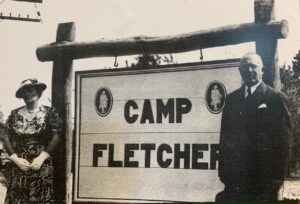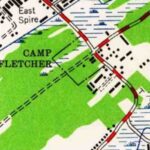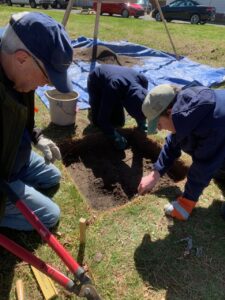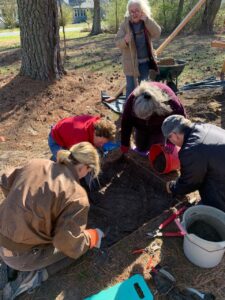Photos: Excavating the History of a Little-Known World War II–era U.S. Army Camp in Chincoteague
At the request of staff from the Museum of Chincoteague Island, DHR’s Eastern Regional Archaeologist Mike Clem spent a week with local volunteers digging for traces of the mysterious camp that was once used by the U.S. Army during World War II.
By Mike Clem

I recently completed an archaeological survey and limited testing at a site in Chincoteague, a town located in the Eastern Shore county of Accomack. The investigation was the result of a collaboration with the Museum of Chincoteague Island. In September of 2022, the museum’s director, Cindy Faith, contacted me to ask if I could find anything out about a U.S. Army camp set up on the island in 1942. I discovered there was very little information about this facility, aside from a local newspaper article detailing the opening day of the camp. There are only a few citizens left in the town who remember anything about the camp, and most people today never knew there was an Army presence there at all. The newspaper article from 1942 included photos of the flag being raised and of the parents of Charles Fletcher, a member of the Coast Guard who lost his life while serving in the Second World War earlier that year. Fletcher was the first casualty of the war to have come from Virginia’s Eastern Shore.
The primary mission of the camp during World War II was to thwart Nazi Germany's plans to bring U-boats close to shore to drop off spies and saboteurs. Army personnel at the camp were trained to patrol the coastline with trained terriers to prevent the enemies from succeeding in their maritime missions. According to sources at the time, U.S. intelligence had intercepted German communications that identified the Chincoteague area as a good target location for such covert missions. The Museum in Chincoteague Island now has a display with a collection of photos and remembrances of some of the older Chincoteague citizens. Some of these citizens recall going to the camp as children and getting candy and food from the soldiers. Others recall playing at the camp after it was abandoned at the end of the war.


With little success in finding any records of the Army camp, the museum staff and I decided that perhaps conducting limited archaeological investigations might help answer some questions. The only document recovered from previous research had been a 1942 United States Geological Survey (USGS) quad map showing several buildings on the lot at the time. After consultations with Faith and the property owners, we agreed to move forward with archaeological testing at the former camp site from March 13 through March 17.
Soon after, museum staff contacted local volunteers. When excavations began on Monday, March 13, approximately eight people showed up from the community to assist with the investigation. Each day during the week of the project, some six to ten people were on hand to help at the site. Others stopped by to visit as we worked. The project was a great success!
Even though very few artifacts were recovered at the end of the survey, everyone learned proper archaeological techniques and, without a doubt, had a wonderful time. We learned preliminarily from the dig – at least until the artifacts are processed and a report is completed – that the Army does a lot of cleanup during and after occupying a place. We found very few objects that we can tie directly to the war period. We also learned that the Army must have moved a lot of earth before – and perhaps after – they used the grounds. None of the soil on the site appeared to be natural and, indeed, each test unit displayed differing soil horizons, which seems to indicate that perhaps heavy machinery was involved in moving the soil.
Through our archaeological investigation, we intended to raise awareness of the Army’s presence at the site as well as the mission of the soldiers stationed at the camp. In that short week, we succeeded in making that happen. On my second night at Chincoteague, I was also asked to give a presentation about other excavations that had been conducted on the Eastern Shore by my team at DHR. I was extremely pleased with the attendance – approximately 40 people from the community showed up. I hope to return to Chincoteague with other DHR archaeologists in the future for further adventures with the citizens of this delightful town. And, if you happen to find yourself in the area, please stop by the museum and see the display about Camp Fletcher.
















